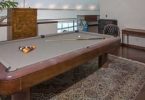A:
- Arch: a curved structure spanning across the top of an opening in a vertical surface
- Abatement: The wastage of wood when lumber is sawed or planed to size
- Abamurus: A buttress, or a second wall added to strengthen another.
- Abrasion: A surface discontinuity caused by roughening or scratching
- Absolute Humidity: The mass of water vapor per unit volume of air
- Acre: A unit of land measurement equal to 43,560 sq ft or 4046.85 sq m; 1 sq mile (2.59 sq km) equals 640 acres.
- Agitator: A mechanical device used to mix a liquid contained in a vessel.
Related: Drawing Test Sample Paper
B:
- Backpriming: The coating of unexposed surfaces of exterior wooden members with primer paint to protect against deterioration.
- Baluster: One of a number of closely-spaced, short vertical pieces providing support for the railing of a balustrade.
- Balustrade: A stair, porch, or parapet railing consisting of a handrail on a series of balusters.
- Bargeboard: a board, often decorative, covering the projecting edge of a gable roof
- Bargeboard: A decorative board attached under the projecting portion of a gable roof.
- Blind Arch: A curved, recessed area above a window or door opening which is in-filled in wood or stuccoes rather than glazed.
- Bolection Molding: On exterior doors, a decorative molding which runs around the panels, overlapping and projecting beyond the door rails and stiles.
- Bracket: An angular support for a horizontal element that projects from a wall
- Bond: A term to describe the various patterns in which brick (or stone) is laid such as “common bond” or “Flemish bond”.
- Box Cornice: A hollow, projecting cornice consisting of soffit board, fascia board, and decorative wooden moldings.
- Bulkhead Doors: The paired, sloping or flat doors that provide exterior access to a basement.
Related: List of Famous Buildings and Architects
C:
- Came: The metal strip, usually of lead, which divides the pieces of glass in a stained glass window.
- Capital: The top element of a column or pilaster.
- Cupola: a small domed structure on top of a roof or larger dome
- Casement Window: A window with one or two sashes which are hinged at the sides and usually open outward.
- Caulking: The non-hardening putty-like material used to seal the joints between dissimilar exterior materials, such as where wood window trim abuts a brick wall.
- Cornice: A continuous, projecting, horizontal element at the top of a wall.
- Corbel Table: a projecting line of masonry or belt courses supported by corbels
- Clapboards: Horizontal wooden boards, thinner at the top edge, which are overlapped to provide a weather-proof exterior wall surface.
- Cornerboard: A vertical strip of wood placed at the edges of a frame building.
Related: Rearrange this sentence
D:
- Dentils: band of small, tooth-like blocks usually used in Classical architecture
- Double-Hung Window: A window consisting of two sashes, one above the other, both of which slide vertically on separate tracks.
- Dome: a roof structure in the shape of a portion of a sphere
- Downspout: A hollow, vertical element, circular or rectangular in cross-section, which carries rainwater down from the roof to the ground.
- Dormer: a roofed projection from a sloping roof often with a window
- Dutchman: A patch spliced into wooden members (where damaged or deteriorated) to match the original construction.
E:
- Eave: the part of a sloping roof that overhangs a wall.
- Efflorescence: The deposit of soluble salts on the face of masonry, brought from within by water entering the wall.
- Entablature: the upper horizontal part of a Classical order, consisting of the cornice, frieze and architrave; similar to a beam
- Entasis: The diminishing taper of the upper two-thirds of a column.
F:
- Facade: Each of the vertical exterior walls of a building, especially the front face.
- Fascia: The vertical surface of the horizontal element which encloses a box cornice or covers the outer edge of a porch floor structure.
- Finial: an ornament at the top of a roof gable, spire or other architectural feature
- Feathered Edge: A diminishing thickness at the edge of new material where it adjoins old, used to minimize the appearance of the joint.
- Fenestration Pattern: The placement and rhythm of window and door openings on a building’s facade.
- Foundation : The lowest exposed portion of the building wall, which supports the structure above.
- Flashing: Thin metal sheets used to prevent moisture infiltration at joints of roof planes and between the roof and vertical surfaces.
- Fixed: A building element which does not move, such as an inoperable window or an artificial shutter.







thanks for the pdf file